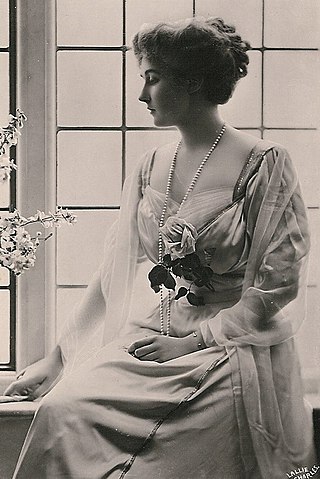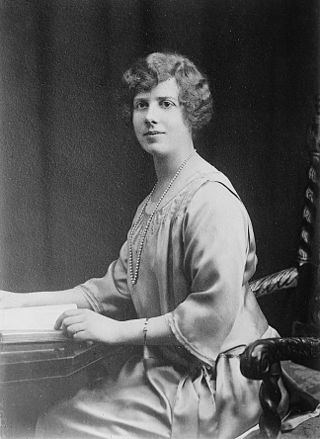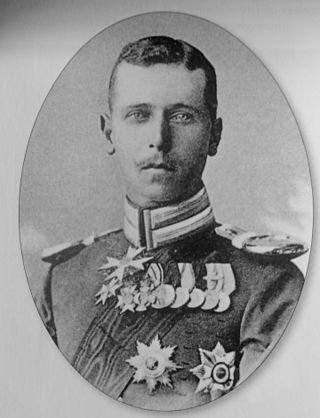
The Act of Settlement is an Act of the Parliament of England that settled the succession to the English and Irish crowns to only Protestants, which passed in 1701. More specifically, anyone who became a Roman Catholic, or who married one, became disqualified to inherit the throne. This had the effect of deposing the remaining descendants of Charles I, other than his Protestant granddaughter Anne, as the next Protestant in line to the throne was Sophia of Hanover. Born into the House of Wittelsbach, she was a granddaughter of James VI and I from his most junior surviving line, with the crowns descending only to her non-Catholic heirs. Sophia died shortly before the death of Queen Anne, and Sophia's son succeeded to the throne as King George I, starting the Hanoverian dynasty in Britain.

Morganatic marriage, sometimes called a left-handed marriage, is a marriage between people of unequal social rank, which in the context of royalty or other inherited title prevents the principal's position or privileges being passed to the spouse, or any children born of the marriage. The concept is most prevalent in German-speaking territories and countries most influenced by the customs of the German-speaking realms.

Princess Margaret of Connaught was Crown Princess of Sweden as the first wife of the future King Gustaf VI Adolf. She was the elder daughter of Prince Arthur, Duke of Connaught, third son of Queen Victoria of the United Kingdom, and his wife Princess Louise Margaret of Prussia. Known in Sweden as Margareta, her marriage produced five children; she was the grandmother of King Carl XVI Gustaf of Sweden, Queen Margrethe II of Denmark and Queen Anne-Marie of Greece. She died 30 years before her husband's accession to the throne of Sweden.

Mountbatten-Windsor is the personal surname used by some of the male-line descendants of Queen Elizabeth II and Prince Philip, Duke of Edinburgh. Under a declaration made in Privy Council in 1960, the name Mountbatten-Windsor applies to male-line descendants of Queen Elizabeth II without royal styles and titles. Individuals with royal styles do not usually use a surname, but some descendants of the Queen with royal styles have used Mountbatten-Windsor when a surname was required.

The House of Windsor is a British royal house, and currently the reigning house of the United Kingdom and the other Commonwealth realms. Since it was founded in 1917, there have been five British monarchs of the House of Windsor: George V, Edward VIII, George VI, Elizabeth II, and Charles III. The children and male-line descendants of Queen Elizabeth II and Prince Philip also genealogically belong to the House of Oldenburg since Philip was by birth a member of the Glücksburg branch of that house.

Prince Arthur, Duke of Connaught and Strathearn, was the seventh child and third son of Queen Victoria of the United Kingdom and Prince Albert of Saxe-Coburg and Gotha. He served as Governor General of Canada, the tenth since Canadian Confederation and the only British prince to do so.

The Royal Marriages Act 1772 was an Act of the Parliament of Great Britain which prescribed the conditions under which members of the British royal family could contract a valid marriage, in order to guard against marriages that could diminish the status of the royal house. The right of veto vested in the sovereign by this Act provoked severe adverse criticism at the time of its passage.

Lady Victoria Patricia Helena Elizabeth Ramsay was a granddaughter of Queen Victoria. Upon her marriage to Alexander Ramsay, she relinquished her title of a British princess and the style of Royal Highness.

Maud Carnegie, Countess of Southesk, titled Princess Maud from 1905 to 1923, was a granddaughter of Edward VII. Maud and her elder sister, Alexandra, had the distinction of being the only female-line descendants of a British sovereign officially granted both the title of Princess and the style of Highness.

The Mountbatten family is a British dynasty that originated as a British branch of the German princely Battenberg family. The name was adopted on 14 July 1917, three days before the British royal family changed its name from "Saxe-Coburg and Gotha" to "Windsor", by members of the Battenberg family residing in the United Kingdom, due to rising anti-German sentiment among the British public during World War I. The name is a direct Anglicisation of the German Battenberg, or Batten mountain, the name of a small town in Hesse. The titles of count and later prince of Battenberg had been granted in the mid-19th century to a morganatic branch of the House of Hesse-Darmstadt, itself a cadet branch of the House of Hesse.

The line of succession to the Swedish throne is determined by the Act of Succession, originally approved jointly by the Riksdag of the Estates assembled in Örebro and King Charles XIII in 1810.
Royal Highness is a style used to address or refer to some members of royal families, usually princes or princesses. Kings and their female consorts, as well as queens regnant, are usually styled Majesty.

The use of the title of Princess of the United Kingdom of Great Britain and Northern Ireland is entirely at the will of the sovereign as expressed in letters patent. Individuals holding the title of princess are styled "Her Royal Highness" (HRH). On 18 April 1917, Frederica of Hanover, the newest granddaughter of Wilhelm II, German Emperor was styled a British princess from birth, even though Germany and Britain were fighting in World War I. Before the First World War, British princesses also held additional German titles, such as princesses of Hanover by virtue of being male-line descendants of George III; or princesses of Saxe-Coburg and Gotha, duchess of Saxony, by virtue of being male-line descendants of Prince Albert of Saxe-Coburg and Gotha. George V issued letters patent on 30 November 1917, to restrict the automatic assignment of the title "princess" and the use of the style "Royal Highness" to the following persons:

Alfred, Hereditary Prince of Saxe-Coburg and Gotha, KG,, was the son and heir apparent of Alfred, Duke of Saxe-Coburg and Gotha. He died aged 24 under circumstances still not entirely clear. He was a first cousin of Kaiser Wilhelm II of Germany, King George V of the United Kingdom and Tsar Nicholas II of Russia.

Succession to the British throne is determined by descent, sex, legitimacy, and religion. Under common law, the Crown is inherited by a sovereign's children or by a childless sovereign's nearest collateral line. The Bill of Rights 1689 and the Act of Settlement 1701 restrict succession to the throne to the legitimate Protestant descendants of Sophia of Hanover who are in "communion with the Church of England". Spouses of Catholics were disqualified from 1689 until the law was amended in 2015. Protestant descendants of those excluded for being Roman Catholics are eligible.

The Danish royal family is the dynastic family of the monarch of Denmark. All members of the Danish royal family except Queen Margrethe II hold the title of Prince/Princess of Denmark or Count/Countess of Monpezat. Children of the monarch and of the heir apparent are accorded the style of His/Her Royal Highness, while other members of the dynasty are addressed as His/Her Highness. The Queen is styled Her Majesty.
The Orléanist claimant to the throne of France is Jean, Count of Paris. He is the uncontested heir to the Orléanist position of "King of the French" held by Louis-Philippe, and is also considered the Legitimist heir as "King of France" by those who view the 1713 Treaty of Utrecht as valid. According to the Family Compact of 1909, only the descendants of Henri, Count of Paris are considered to be French dynasts. The founders of the cadet branches of Orleans-Braganza and Orléans-Galliera, by becoming foreigners, are considered under house law to have lost their rights to the throne.
Since William the Conqueror claimed the English throne, succession has been determined by bequest, battle, primogeniture, and parliament.

The Succession to the Crown Act 2013 is an Act of the Parliament of the United Kingdom that altered the laws of succession to the British throne in accordance with the 2011 Perth Agreement. The Act replaced male-preference primogeniture with absolute primogeniture for those in the line of succession born after 28 October 2011, which means the eldest child, regardless of gender, precedes any siblings. The Act also repealed the Royal Marriages Act 1772, ended disqualification of a person who married a Roman Catholic from succession, and removed the requirement for those outside the first six persons in line to the throne to seek the Sovereign's approval to marry. It came into force on 26 March 2015, at the same time as the other Commonwealth realms implemented the Perth Agreement in their own laws.

Victoria, Queen of the United Kingdom of Great Britain and Ireland and Empress of India, died on 22 January 1901 at Osborne House on the Isle of Wight, at the age of 81. At the time of her death, she was the longest-reigning monarch in British history. Her state funeral took place on 2 February 1901, being one of the largest gatherings of European royalty.





































